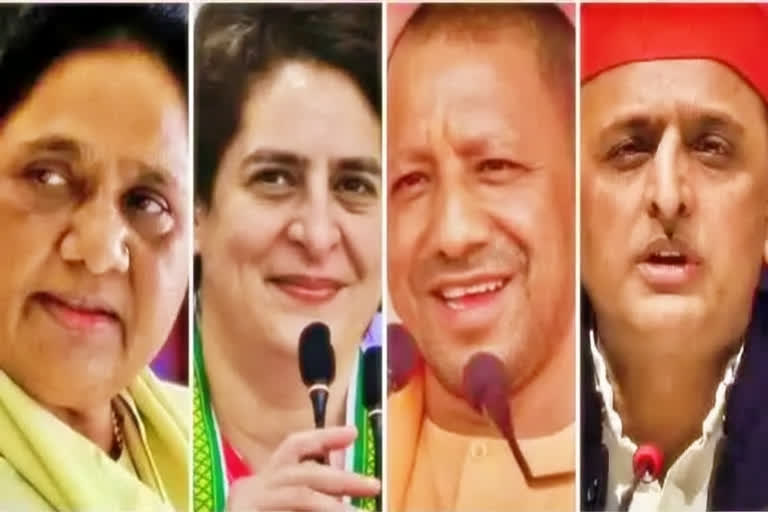The campaign for the Uttar Assembly election has turned into the aggressive mode as, with announcement of candidates for up to the fourth round, political parties also get real about where they stand. Despite the claims and counter-claims, ground-level feedback reaching parties’ headquarters in Lucknow has made their leaders realise which way the wind might blow in the next few days. Polling for the 403-member Assembly begins on February 10 and will continue in seven phases up to March 7. The counting is on march 10 and the results could be out the same day.
The pace of campaign for at least two contenders – the incumbent Bharatiya Janata Party (BJP) and the past winner Samajwadi Party (SP) – has become quite frenzied with their leaders’ utterances becoming harsh, apparently in order to send a message to supporters that are not to be intimidated. The other participants, such as the Bahujan Samaj party (BSP), Congress and the Bhagidari Parivartan Morcha (BPM) comprising AIMIM and other parties, too are taking an aggressive stance as they have begun to realise that the election could be open, rather than a bipolar affair.
Given the electoral history of no political party getting a second chance to rule at least since 1989, and the re-emergence of caste divisions after a brief interval, the state is poised to see an interesting fight ahead. The BJP, buoyed by the popularity of Narendra Modi, had managed to get the support of all sections within the Hindu community in the 2014 Lok Sabha election, 2017 Assembly election and also in the 2019 Lok Sabha election. However, it also meant that no particular caste was given any preferential treatment, as used to be commonly expected in previous regimes. As a fall-out, it also meant that no caste (or castes) felt it was their government.
OBC reassertion
The collective impact has led to a re-assertion of the other backward castes (OBCs) and most backward castes (MBCs) to seek a place in the ruling dispensation -- apparently the attempt of the BJP to keep the OBC support intact has not been enough. It was apparent in the manner in which BJP ministers and legislators belonging to the OBCs and MBCs left party in the last couple of months. Most of them gave a similar explanation for their action – so similar that it appeared to be scripted at one place by one person.
Also read: Will farmers push back BJP’s communal politics?
While it may be argued that the defections also reflected the unease of leaders about their victory but it did create a perception that the BJP had not been able to keep its flock together. It has also raised new questions about the importance of some castes and communities: are Yadavs, Muslims, Brahmins and Dalits not as important as other OBCs and MBCs?
The answer to this question could emerge after all parties release their lists for all the 403 seats. But the eagerness to bet on OBCs, MBCs and Muslims – followed by other sections – is apparent in lists announced by all parties so far. The SP led by Akhilesh Yadav has allied with Suheldev Bharatiya Samaj party (SBSP) of Om Prakash Rajbhar and the Rashtriya Lok Dal (RLD) led by Jayant Chaudhary, besides some other small parties. Even the BPM combine, comprising Asaduddin Owaisi’s AIMIM Jan Adhikari Party led by Babu Singh Kushwaha, the Bharat Mukti Morcha led by Vaman Meshram,
Janata Kranti Party led by Anil Singh Chauhan and Bhartiya Vanchit Samaj Party led by Ram Prasad Kashyap, has announced that it will contest the elections on the issue of representation in proportion to population and caste census, among other things. Amidst all this, Dalits seem to be adrift, as they had sided strongly with the BJP in 2014, 2017 and 2019, and now Mayawati is inviting them to support her BSP again. She continues to remain a symbol of Dalit dignity and many of her staunch followers feel the community will come back to her for this reason only.
Also read: UP Elections 2022: How Akhilesh emerges as a strong contender against Yogi?
The BJP campaign has clearly become SP-centric now, with Modi, Amit Shah and Yogi Adityanath steadily targeting the SP, the red cap worn by Akhilesh Yadav and SP workers, and some usual accusations against the SP. The BJP is also facing accusations of its legislators and ministers being inaccessible and unhelpful. Its campaign focuses on the infrastructure related work done in the state and the crackdown on communal violence and organised crime.
While Akhilesh seems to be gathering steam with his strident attacks on the BJP, a revival of the Muslim-Yadav (MY) combine and an election machinery that is relatively better-managed than that of the Congress, BSP and others is helping him. The BJP is also depending heavily on the appeal of Prime Minister Narendra Modi, Chief Minister Yogi Adityanath, and management skills of Amit Shah. The moot question that is still open to an answer is: Polarisation beyond a point has not worked in elections before 2017. Will it work this time?
(Disclaimer: The opinions expressed in this article are that of the writer. The facts and opinions expressed here do not reflect the views of ETV Bharat.)
Also read: The Battle for Western Uttar Pradesh



